Your Cart is Empty
Beginners Guide to Paintbrushes
There are many different types of paint brushes on the market today, and as a beginner it's not surprising that we get very confused and overwhelmed! There are lots of different brands, shapes and different sizes and most of the brushes serve very different functions. Fear not! We are here to guide and support your creative journey, to discuss the different characteristics and properties of each paint brush.
Over the course of this article we will cover what type of brush is recommended for watercolours, gouache, oils and acrylics. We have created this beginner's guide to help you find the right paint brush for your creative needs and painting style; hopefully saving you money and time. Not all brushes are made equal and nor can the same brush be suitable for all types of paint, so we have started by outlining what brush is best suited to what medium. You will have lots of choices for you to select the right synthetic bristles or natural hair bristles depending on your style and personal preference and medium. We hope after reading these guidelines you will come to understand how many brushes you actually need and the functions they serve. You may be surprised to find that a good set of brushes will provide you with all your technical needs and that many different marks can be made with the same brush!
Anatomy of a paintbrush
Bristles
This refers to the end of the brush which transfers the paint onto the substrate surface. The type of bristle used may be different for each of your brushes, if you are a vegan artist you should look for completely synthetic brushes which are readily available on the market. There are lots of brushes made out of animal hair and this should be identified in the description on the packaging.
Animal hair used for watercolour painting brushes are usually Squirrel, Sable, Weasel, and Mink. Kolinsky Sable is regarded as the best bristle for watercolours and are considered to be high quality brushes but are probably the most expensive. Synthetic brushes have been made to mimic the quality of animal hair and are used by both professionals and students.
Animal hair used for oil painting brushes include; Hog, Goat, Badger, Pony, Sheep and Ox. Again synthetic brushes have been developed to mimic the various qualities of these animal hairs and are believed to be just as effective.
Acrylic paint brushes are mostly nylon or synthetic and are animal friendly, however some oil brushes will work for heavier applications of acrylic paint also. Specifically Acrylic brushes are designed to deliver medium to heavy viscosity paints.
The end of the bristles are referred to by the toe or tip. The middle of the brush which carries the water and pigment, or oil and pigment is called the belly of the brush. The belly of the brush is basically a reservoir holding the right amount of pigment to deposit through the tip of the brush, depending on how much pressure you use on application.
Ferrule
The ferrule is a metal band that holds the bristles of the brush in place, the flat section at the top of the ferrule nearest the bristles is sometimes referred to as the heel and joins them to the handle. The end of the Ferrule which holds the brush onto the handle is often crimped for extra strength. Ferrules can be made out of stainless steel, brass, copper, aluminium, nickel, and sometimes plastic.
Handle
The handle comes in all lengths and shapes. Often made from wood or moulded plastic. The length of the handle usually indicates what medium you are using and what style. For oil painters a long handle is favoured to enable ease of movement whilst standing at an easel, especially when long arm movements are required for creating long lines during live model painting or plein air painting at an easel. A short handled brush would be needed for detailed and intricate work close to the canvas or paper. A wide handle would be needed if the brush was used for varnishing and bold strokes were needed.
Artists' Paint brushes also have many sizes!

Each brand of brush will have their own size ranges, and are not consistent, for example a size 1 in one brand might be a size 4 in another!. Do not be tempted to buy every single size they offer you! You do not need the whole range. Round brushes seem to go from 000 up to 30, or even larger! The higher the number usually indicates a larger brush head.
Flat brushes are usually measured in inches for example; 1 inch, 2 inch, 4 inch, 6 inch and 8 inch. Not all brands will have brushes available in these sizes ranges.
What type of brush do I need for watercolour and gouache paint?
Traditionally watercolour painting will require soft bristles that will hold plenty of pigment and water in its belly and will spring back into shape. They should glide onto the paper and deposit a good amount of wet paint smoothly and consistently. Watercolour painting brushes are designed to have a soft hair bristle so they are ideal for painting large areas with floods of pigment or alternatively they can be extremely sensitive to applying very fine details. Fortunately you do have a large selection of synthetic brushes, blended (a mix of animal and synthetic) and animal bristles at your disposal, most of them claiming to do just that. Also most watercolor painting brushes are extremely versatile and will serve both watercolour and gouache painting, although it is better to have dedicated brushes for each medium you use.
When starting out, you should aim to buy at least 3 round brushes, small, medium and large. These brushes will serve a multitude of purposes. Round brushes should hold their shape and come to a fine point. Then aim for a medium size flat brush, medium size filbert brush and possibly a mop brush. You can always buy extra brushes to build your tool box when you become more accustomed to brush types and their functions. There are lots of specialist brushes listed below to help you decide what else you need.
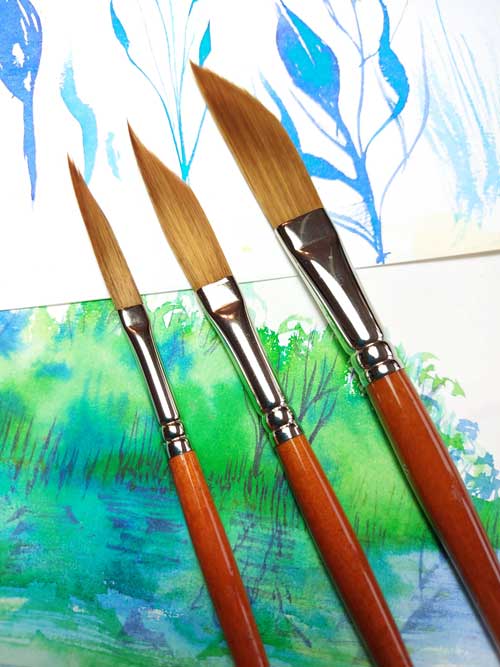
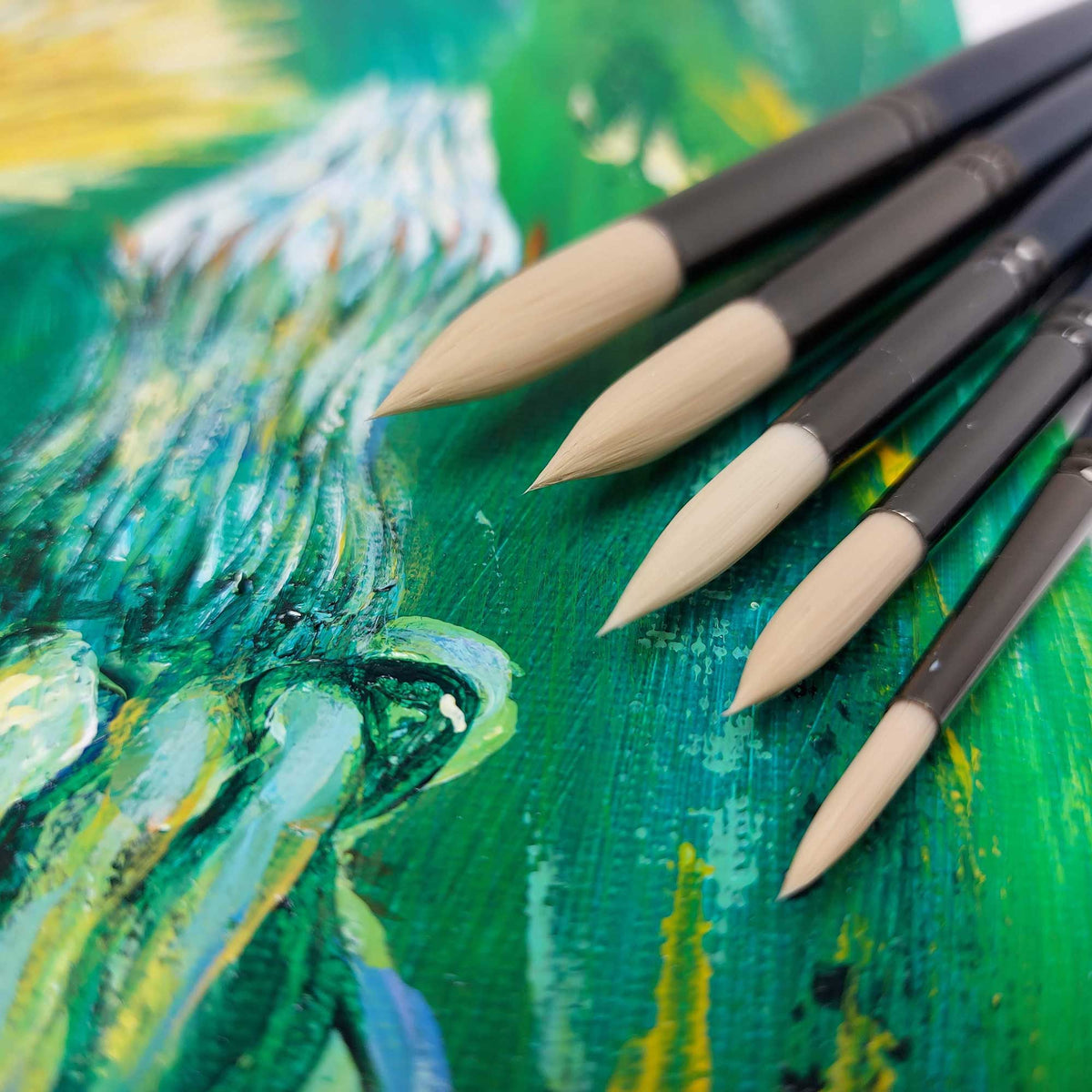
What type of brush do I need for acrylic paints?
For Acrylic painting your brushes can be a little bit sturdier and firmer as the thicker consistency of the paint requires a stronger brush. You should be looking for synthetic filaments which give the brush both spring and strength. Taklon is a good brush for Acrylic painting and aims to mimic the characteristics of natural sable, they are softer than nylon but give a sharper and more precise working edge and tip. Rounds, filbert and flats and a fan are all good brushes to have. But remember to clean them immediately after use.
What type of brush do I need for oil painting?
Ideally when looking for oil painting brushes you need brushes that will not shred, will hold their shape, carry the paint and not disintegrate when cleaned with solvents! Most oil painting brushes have long handles so you can create expressive paintings. Most artists own a selection of sizes in rounds, filberts and flats. Hog brushes are very popular, as they are tough and will hold thick oil paint well. Also sable is used for a softer bristle. A good firm brush should hold its shape whilst painting.
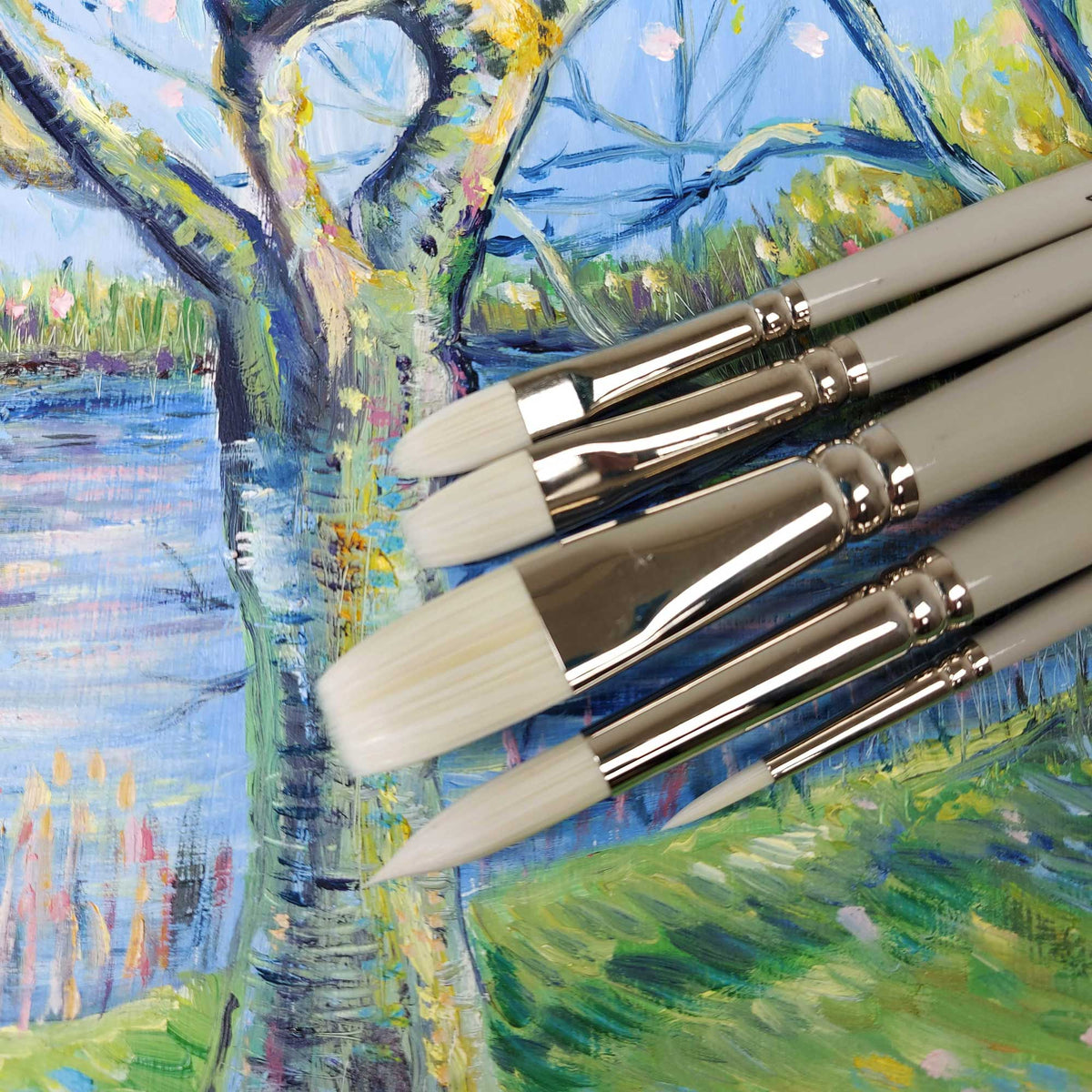
Types of paint brushes and their functions
Round brushes
Have a large belly and a long tapered end.
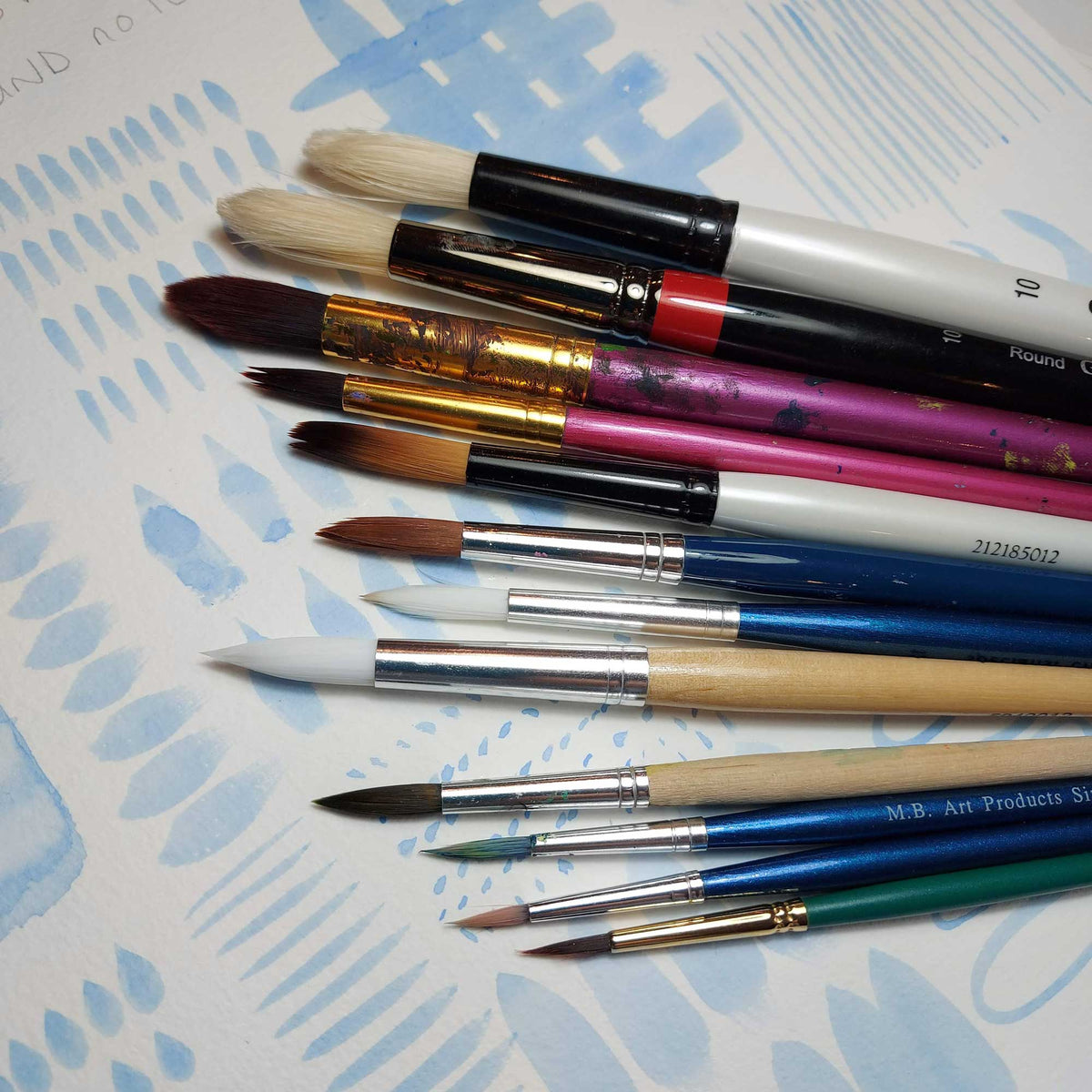
A round brush can be found in many sizes and is extremely versatile. The large rounds can be used for long and bold strokes for applying sweeps of colour and wetting the paper, whilst a small round brush is ideal for applying drawing out your composition, adding detail and intricate fine line work. It is always worth owning at least 4 good round brushes in various sizes. Round brushes are great for all types of mediums, Watercolour, Gouache, Acrylic, and Oils. The handle lengths and bristles will vary depending on which medium you are using.
View productsPointed round brush
Round with an elongated point and tip.

An adaptation of the round, it has an extra fine taper point for accuracy and fine detail work, plus the belly to hold colour. Winsor & Newton Professional Watercolour Synthetic Sable Brushes. They come in sizes 2, 4, 6, and 8. Their ergonomically designed handle will provide comfort whilst painting for long hours. Also comes in sable Winsor & Newton Artists Water Colour Sable Brushes - Pointed Round
View productsFlat brushes
Square in shape and flat.
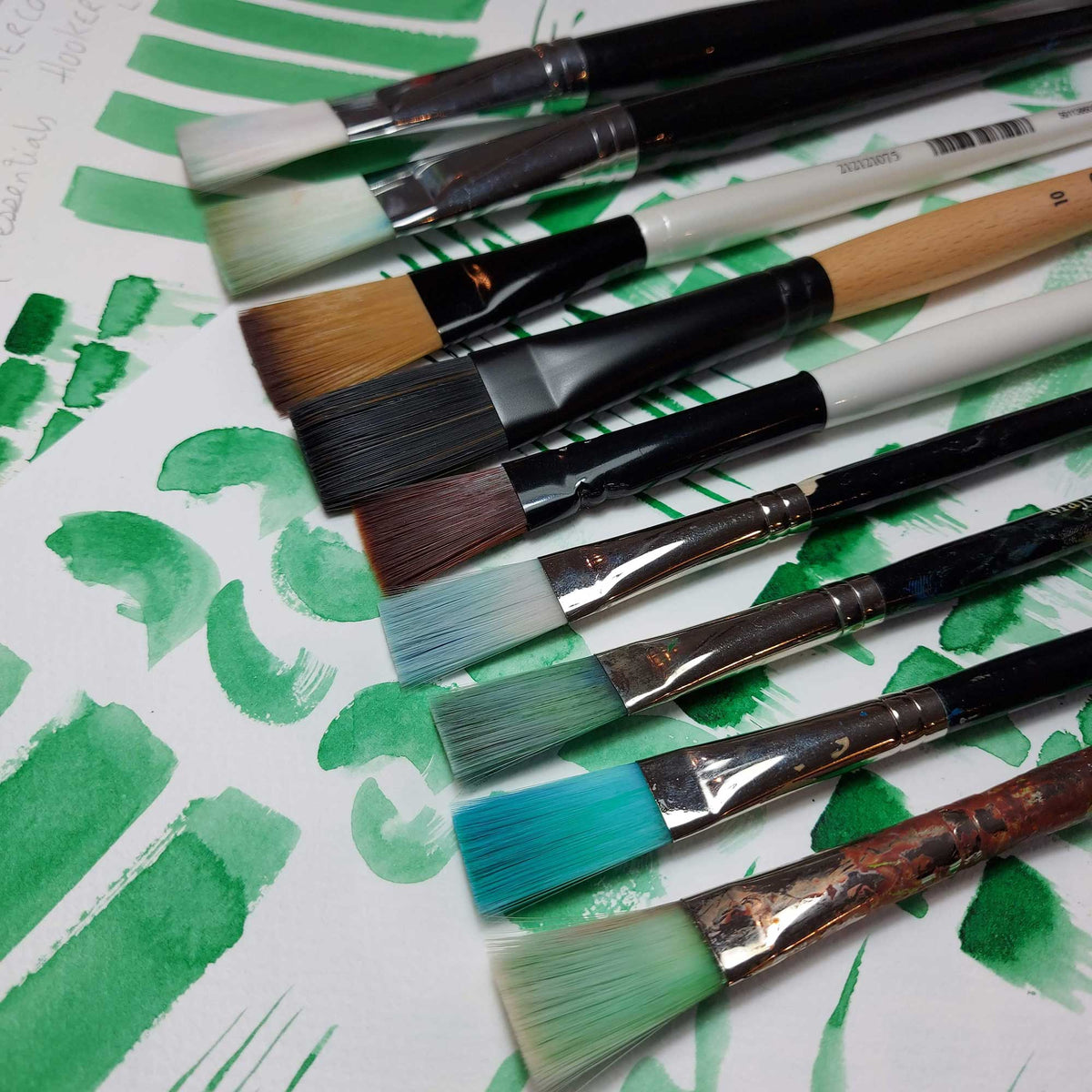
A flat brush is exactly as its name implies, square in shape and flat. This brush is available in many sizes similar to the round brush and can be bought with various bristle qualities to suit the respective medium being used. Ideal for Watercolour painting, Gouache, Acrylic and Oil painting. Used for bold strokes, blocking in areas of colour, washes of colour, creating neat edges, lines and stripes. Long haired flat brushes are great for varnishing. A good quality flat will have spring and snap.
View productsBrights
Similar to the flat brush but with shorter bristles.

Similar to the flat brush in shape, but with shorter bristles. This shorter version is great for getting closer to the canvas or paper, for more controlled work and strong linear strokes and creating stripes.
View productsFan brushes
Fan shaped flat head brush
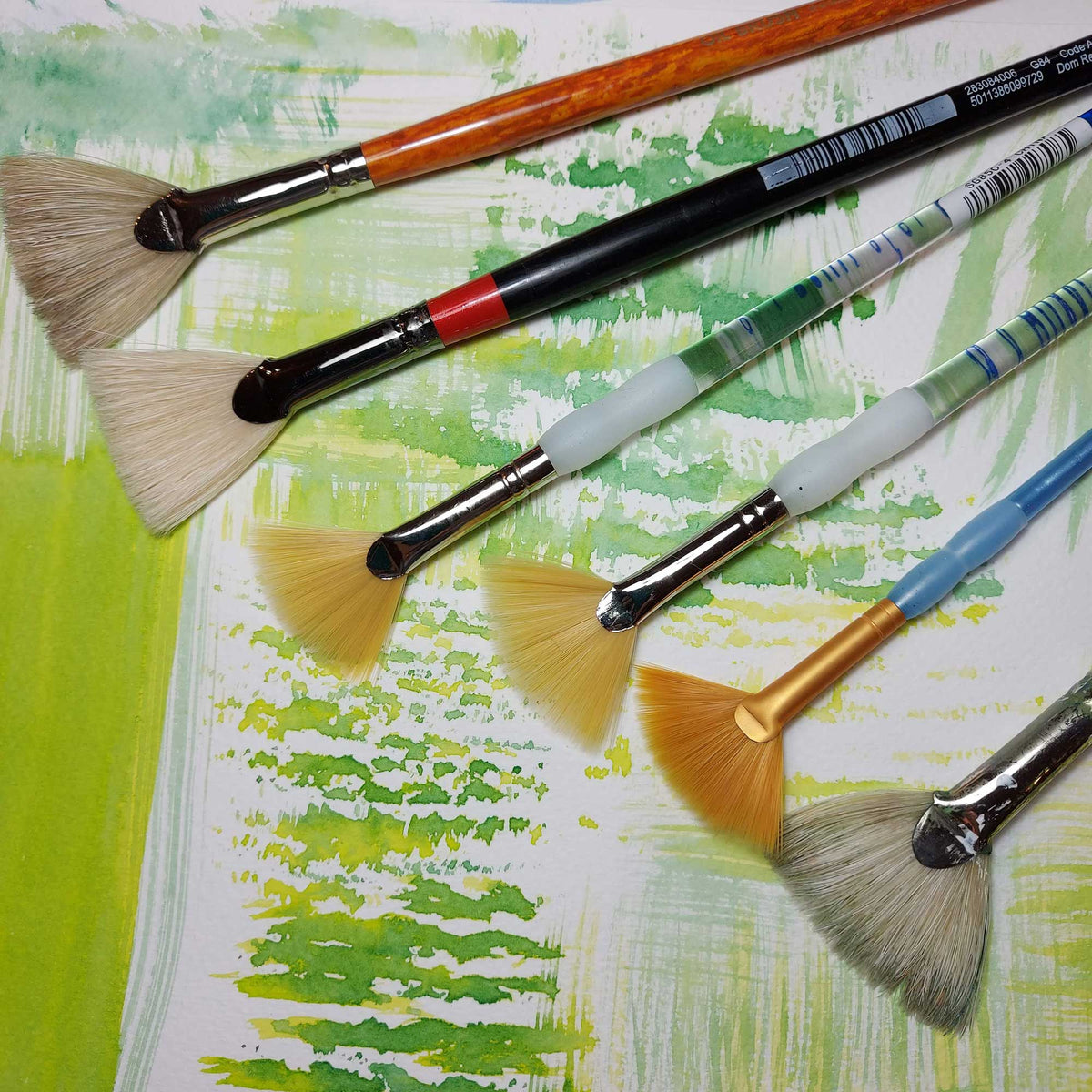
A Fan brush is one of those brushes that just keeps giving. An excellent brush for textural effects, perfect for foliage, grasses, stippling, creating leaves on distant trees, creating grasses and for blending colours. Even when some of the bristles are bent and have fallen out, this brush will providea you with a varied and unique textural effect that no other brush will. Use horizontally and vertically.
Filbert brush
Similar to a flat brush but with a curved tip or toe.
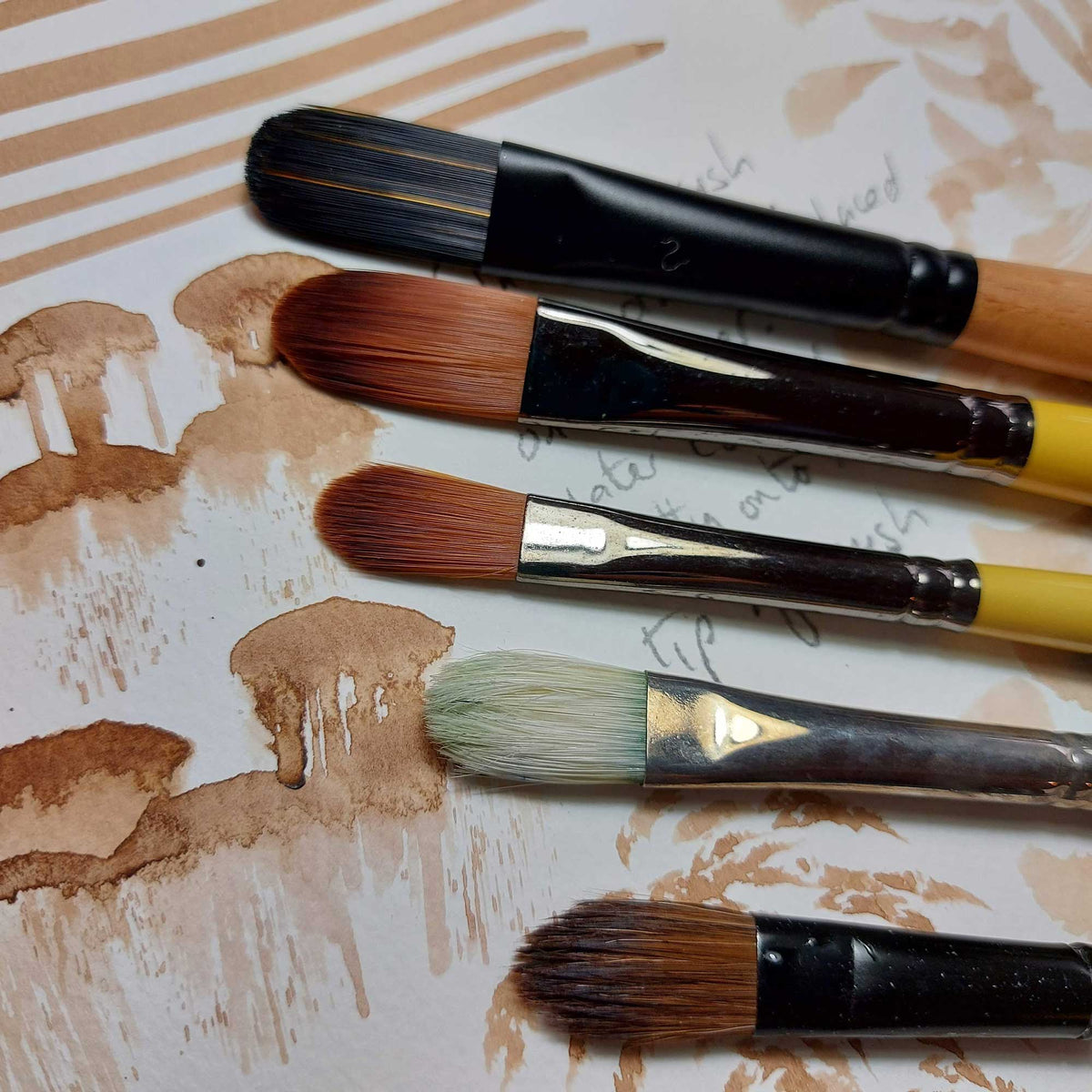
A filbert brush is another great tool box staple. They can have a medium to long filament and serve many functions. Most commonly used in Acrylic and Oil painting, however some soft synthetic filbert brushes are great for creating watercolour petal shapes. They can be used as a blender brush, or use the sides for creating detail or use flat for covering medium to large areas.
View productsAngular brushes
Sword or dagger
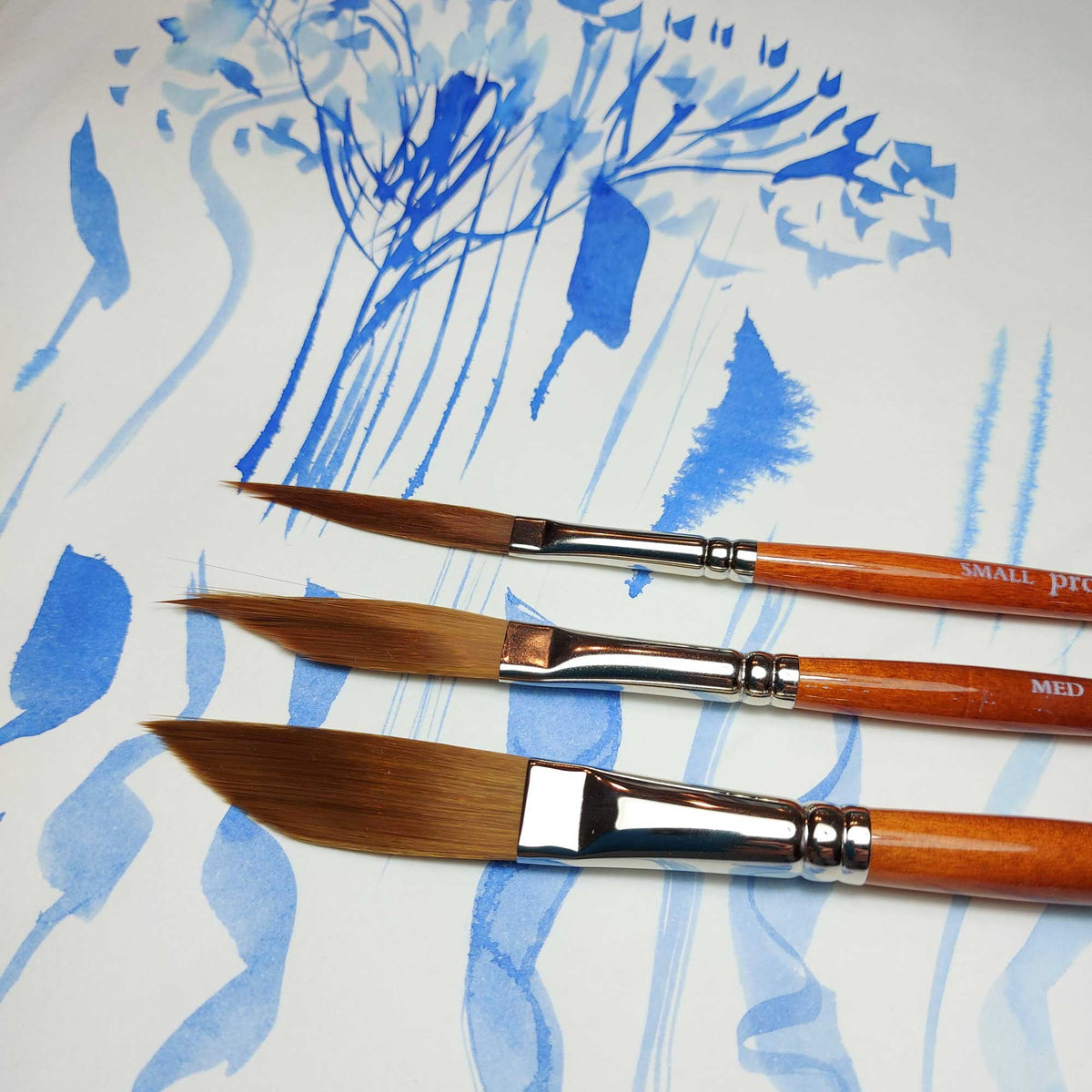
Angular brushes have different hair lengths and as the name suggests are cut at an angle. These brushes are great for creating precise details, using for one stroke and creating unique brush strokes especially when they are loaded with multiple colours.
View productsMop brushes
Large, broad and round.

Mop brushes are round, have a big belly and come to a point, but they serve the same kind of functions as wash brush. They need to be soft but springy and are used for covering large areas in watercolour paintings. Used for spreading washes of colour to create glazes or for just spreading water for a wet on wet technique over large areas. Also used for absorbing too much water or paint on a surface. These brushes are excellent to use with inks.
View productsWash brushes
Large, broad and flat.
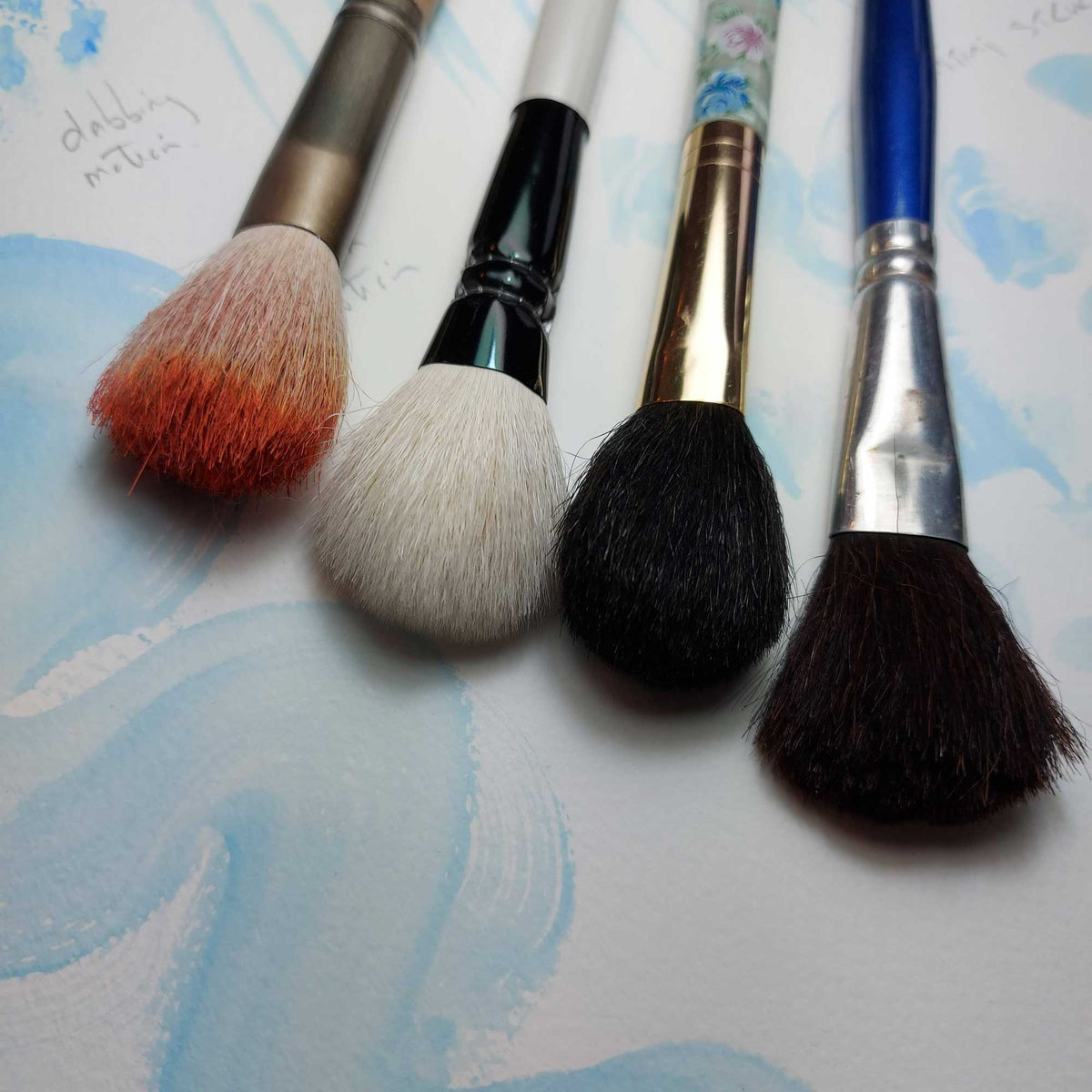
Mop and wash brushes are found to be made mostly out of animal hair but you can buy synthetic equivalents. Wash brushes are usually wider and flatter than a Mop brush. Used for spreading washes of colour to create glazes or for just spreading water for a wet on wet technique over large areas. Also used for absorbing too much water or paint on a surface. Excellent to use with inks.
View productsLiner/script and rigger brush
Long and thin
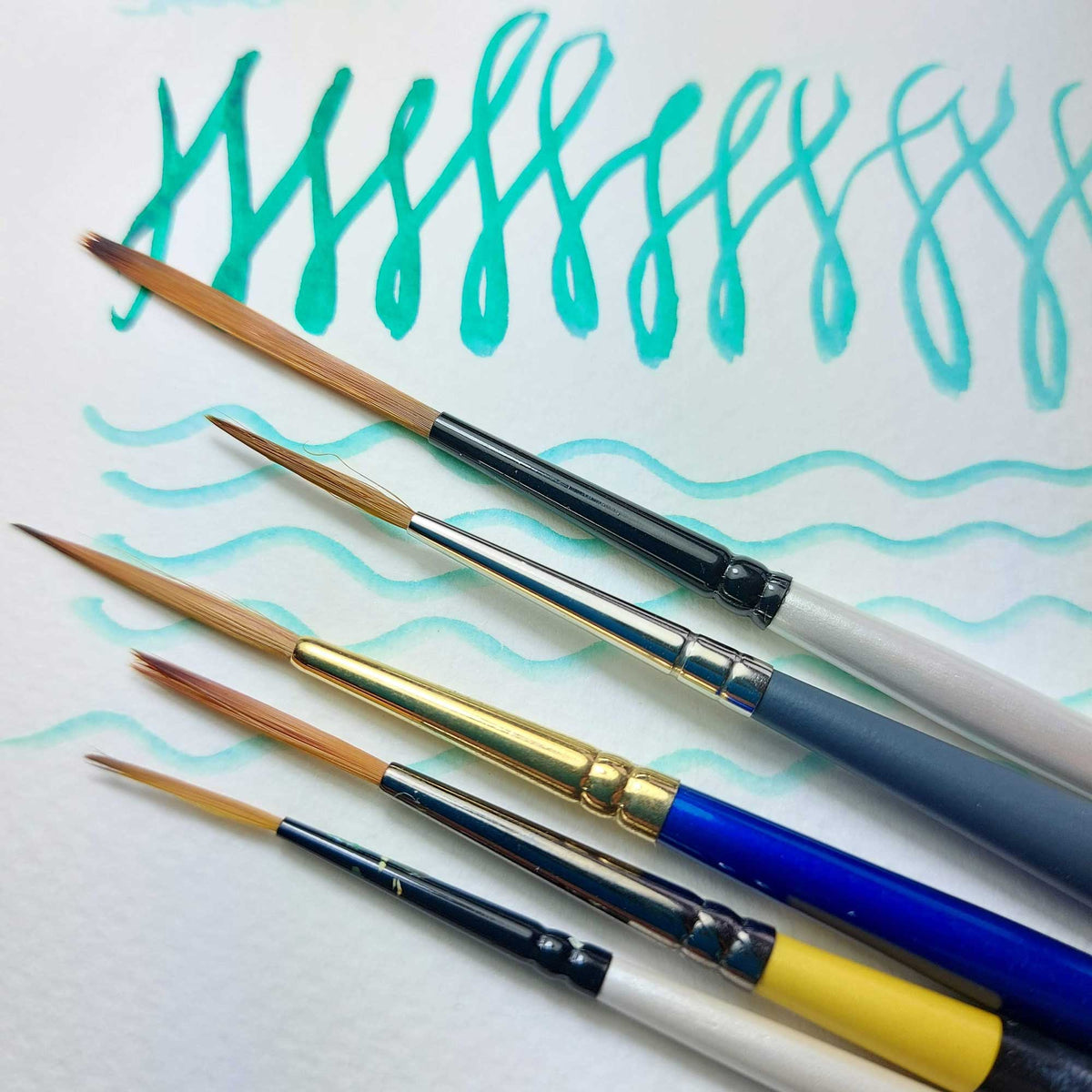
Long and thin brushes with long bristles for creating long straight lines with one brush stroke. Excellent for rigging, painting animal fur, whiskers, long hair, blades of grass, branches, trees, ropes and fences.
View productsSpotter brush
Small, round with short bristles.

Spotters are small round with shorter bristles for extra control. They are used for minute detailing, creating highlights and when you want to apply the smallest of paint spots on your paper or canvas. Also used for retouching.
View productsBlender brush
Soft bristle

Usually a soft bristle goats hair brush. Used for softly blending oil paints where your artwork requires a soft edge for example clouds, water and foliage.
View productsLiquitex splatter brushes
Splatter effects.
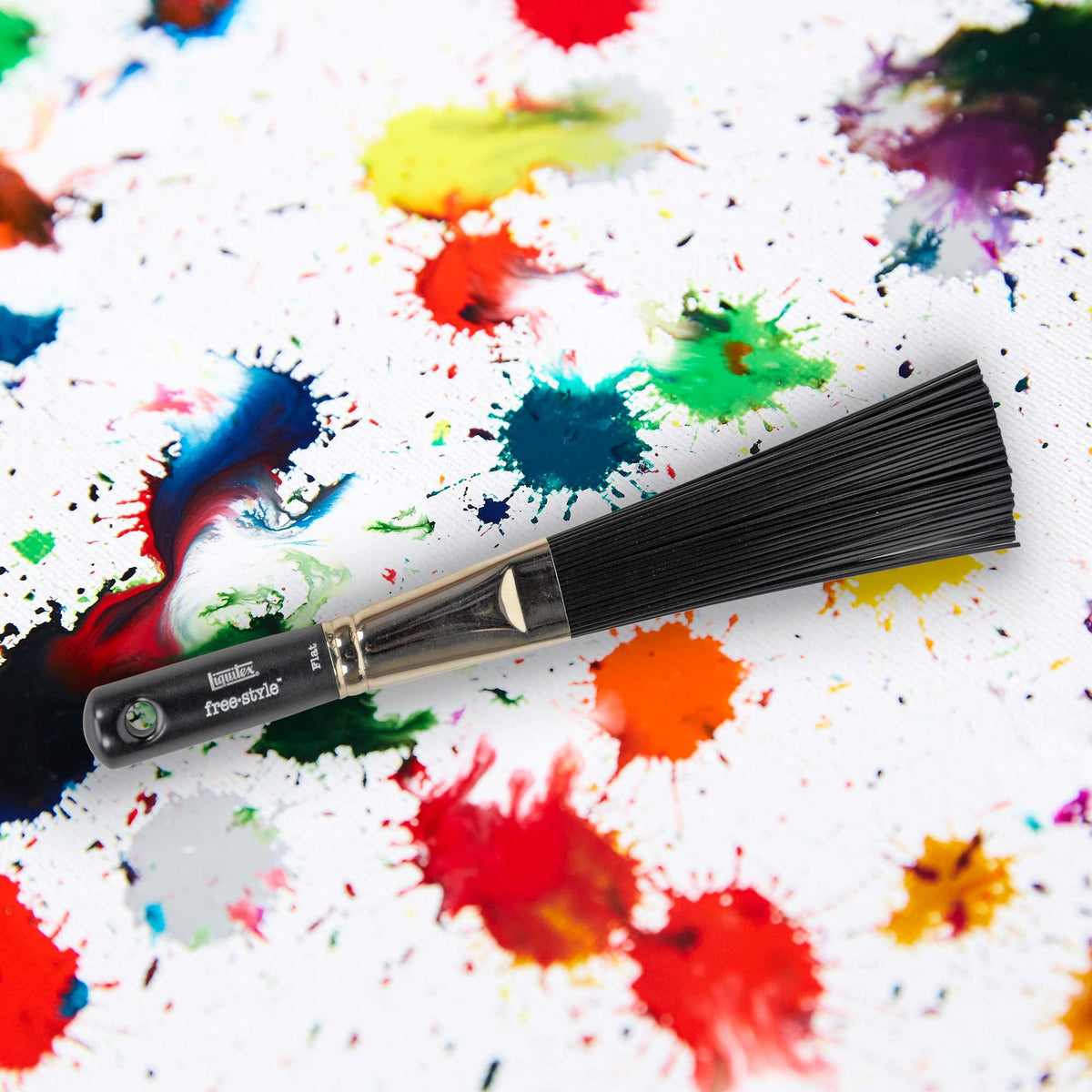
This brush is great for creating unique splatter effects. The Freestyle Splatter brush is available in Round and Flat shapes that each create different marks. These brushes are ideal for use with soft-body acrylic colours or acrylic inks.
View productsLiquitex Short Handle Paddle Brush
Pocket size for portability
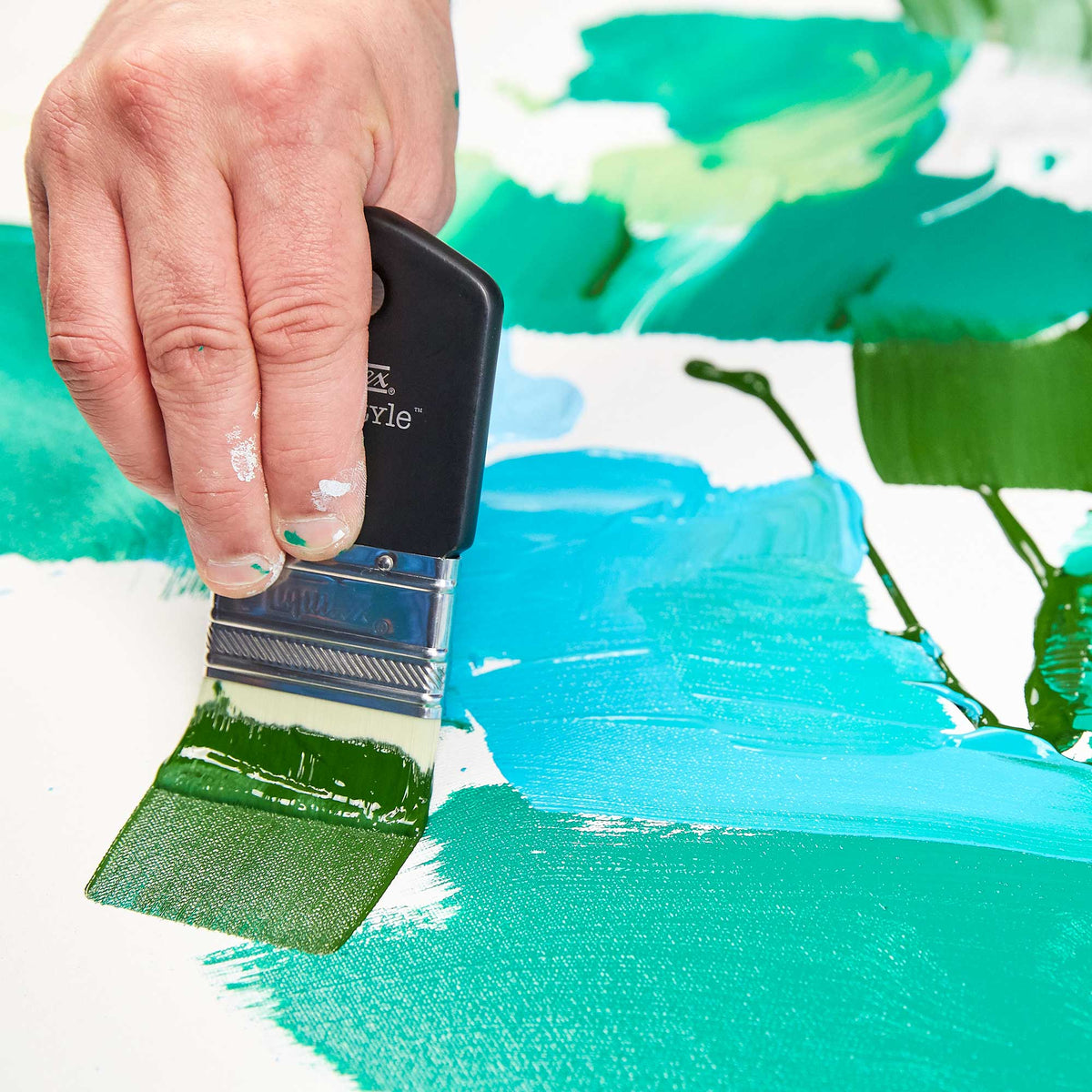
The paddle brush is useful for painting both broad marks and edges. Use it for covering large surfaces, spreading thick colour, and for smoothing or smudging. Its short length out of the ferrule allows for easy movement of thick colour and mediums. It can be used with acrylics and water-mixable oil paints.
View productsVarnish brushes
Wide and flat

Dedicated brushes specifically for applying Varnish to paintings, oil or acrylic, usually wide and flat for maximum coverage with one stroke. Comes in sizes 1 inch, 11/2 inches and 2 inches.
View productsOil painting brush sets
- ARTdiscount Pro Oil & Acrylic Flat Brush Set of 6
- ARTdiscount Pro Oil & Acrylic Round Brush Set of 7
- ARTdiscount Pro Oil & Acrylic Filbert Brush Set of 6
- Daler Rowney Georgian Oil Brush Classic Collection
- Winsor & Newton Winton Long Handled Hog Brush - 3 Brush Wallet
- Pro Arte Series D Bristlene Oil Brushes (W16) - Set of 5
- Pro Arte Series C Studio Hog Brush Set W11
Acrylic paint brush sets
- ARTdiscount Pro Oil & Acrylic Flat Brush Set of 6
- ARTdiscount Pro Oil & Acrylic Round Brush Set of 7
- ARTdiscount Pro Oil & Acrylic Filbert Brush Set of 6
- ARTdiscount SAMPLE Acrylic Brush Set of 5 Brushes
- Winsor & Newton Professional Acrylic Brush Set
- Pro Arte Scholar Brush Set 34WB
- Daler Rowney System 3 - Classic Brush Set
- Daler Rowney System 3 Acrylic Brush Wallet (501)
Watercolour and Gouache paint brush sets
- ARTdiscount Pro Watercolour/Gouache Round Brush Set of 8
- ARTdiscount Pro Watercolour/Gouache Flat Brush Set of 6
- ARTdiscount Pro Watercolour/Gouache Filbert Brush Set of 6
- Pro Arte Polar Brush Set 31WB
- Pro Arte Prolene Brush Set W3
- Pro Arte Prolene Brush Set W5
- Pro Arte Prolene Brush Set W1
- Pro Arte Sablene Brush Set - W15
- Derwent Techniques Brushes
- Daler Rowney Aquafine Watercolour Brush Classic Collection
How to clean your Brushes - here are a few tips to keep your brushes tip top!
- Never use your Watercolour or Gouache or Acrylic painting brushes for Oil painting, this will destroy their soft nature.
- Clean your brushes immediately after you finish painting, this will prevent any clogging and build up of paint which will damage your bristles, especially acrylic paint. Acrylic paint if left to dry will destroy your brushes as it dries waterproof.
- Never leave your brushes in water for long periods, this will cause your bristles to bend out of shape and if the water level is higher than the ferrule, it will soak and damage the handle especially if it is wood.
- There are certain products which will help you to clean your brushes depending on which medium you are using. See list with links below;
For Oil painting brushes - you can use Bob Ross Odourless Thinner and Bob Ross Brush Cleaner and Conditioner - 100ml.
For Watercolour brushes - basically clean water and a little mild soap. Dry bristles up.
For Acrylic brushes - The Masters Brush Cleaner 75ml, also warm water and mild soap.

How to store your brushes
Looking after your brushes will sustain their longevity especially if you have a favourite brush. After cleaning and drying your brushes it is recommended that you store them away from potential pollutants, little inquisitive hands or our sharp toothed furry pets! We have listed some products here that might help protect and store your brushes and make it easy to transport.
- Mapac Brush Easel Case
- Mapac Long Black Brush Case
- Mapac Canvas Brush Roll
- Black Mapac Brush Roll
- ArtBin Essentials Brush Box
- Plastic Brush Holder
- Loxley Howden Artists Storage Chest - Single Box

For more information on brushes go to blog: Introducing the Winsor & Newton Professional Watercolour Synthetic Sable Brushes.
Hopefully this has helped demystify what brushes are available to you and what their functions are, but the best way to find out their potential and limitations is to create some brush charts. Aim to use a variety of pressures and sweeping gestures to find the right mark for your artwork. Alter the way you hold the brush, by the tip and vertically for long stroked sketches, or hold it near the ferrule for detailed and more controlled work. Frequently change the angle of the brush, use the tip, side or full belly this will provide you with a multitude of different strokes. Most of all enjoy the process!


